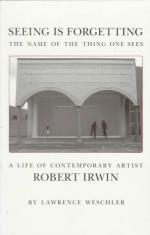
|
| Name: _________________________ | Period: ___________________ |
This test consists of 15 multiple choice questions and 5 short answer questions.
Multiple Choice Questions
1. Robert's focus now becomes what?
(a) The windows.
(b) The lighting and the walls of the room.
(c) The viewer.
(d) The floor and ceiling.
2. Descartes argued that the fundamental moment when everything is stripped away occurred where?
(a) In the cognito.
(b) In the cogito.
(c) In the congo.
(d) In the incognito.
3. Robert installs a project in a museum to make what case?
(a) That his art can be displayed anywhere.
(b) That the museum should accept him.
(c) That museums are worthwhile.
(d) That the museum is irrelevant.
4. Later during his disc period, Irwin is able to work with plastic discs, which provide what?
(a) A safer work environment.
(b) Ease of transport.
(c) The added element of translucence.
(d) Weightlessness.
5. Irwin, through his journey of self-discovery, has learned to do what?
(a) Deal with presence without the reductiveness.
(b) Deal with presence with the reductiveness.
(c) Deal with presence with the deductiveness.
(d) Deal with presence without the deductiveness.
6. At a 1971 display at UCLA's museum, Irwin redoes a utility stairway with what?
(a) New stairs.
(b) A new color palette.
(c) A new railing.
(d) New lighting and other minor adjustments.
7. After gaining understanding of the basics, Irwin does what?
(a) Writes his own view of the philosophy.
(b) Talks to others about this philosophy.
(c) Gives lectures about this philosophy.
(d) Creates art inspired by this philosophy.
8. During this time period, Irwin works on __________ projects.
(a) Scrim.
(b) Disc.
(c) Dot.
(d) Line.
9. Irwin's discomfort with paintings that encompass the edges of the canvas leads him to move on to painting what?
(a) Floors.
(b) Discs.
(c) Walls.
(d) Ceilings.
10. He uses vast lighting to feature a project in Berkeley and is disappointed when?
(a) The lighting itself receives more attention than the space.
(b) The color itself receives more attention than the other elements.
(c) The lighting itself receives more attention than the color.
(d) The space itself receives more attention than the lighting.
11. Why does Irwin not make art in the Mojave?
(a) He does not know what to make.
(b) He has no supplies to make art.
(c) He does not want to destroy the beauty of the area.
(d) He has no interest in art.
12. What three elements are equally positive?
(a) Wall, floor, ceiling.
(b) Viewer, window, disc.
(c) Wall, shadow and disc.
(d) Wall, window, shadow.
13. The room implicitly represents what?
(a) Happiness.
(b) A journey to a new beginning.
(c) The Mojave Desert.
(d) Simplicity.
14. Irwin takes many day hikes into the flat terrain and stays where at night?
(a) Under a cactus.
(b) In wolves' dens.
(c) In seedy motels.
(d) Under the stars.
15. Do many viewers "get it?"
(a) Yes, some.
(b) Yes, but very few.
(c) No.
(d) Yes, many.
Short Answer Questions
1. ___________ years after the Whitney opening, Irwin is busy with multiple proposals for projects for cities and universities.
2. He adds a thick black tape to the floor to form what?
3. What does Irwin feel will help clear his mind in his journey of discovery?
4. In 1970, the young curator of the Museum of Modern Art in New York invites the controversial Robert Irwin to do what?
5. Robert's installations were made based on what?
|
This section contains 544 words (approx. 2 pages at 300 words per page) |

|




